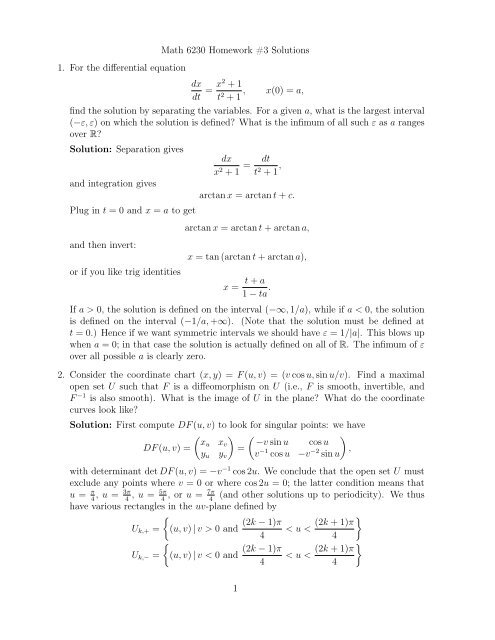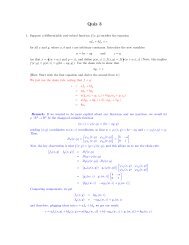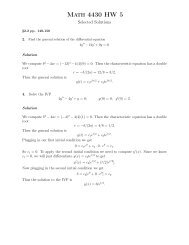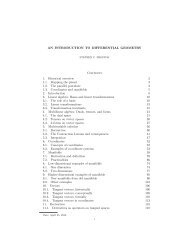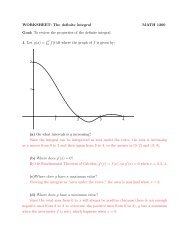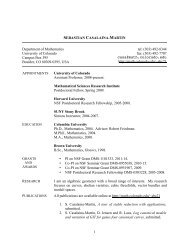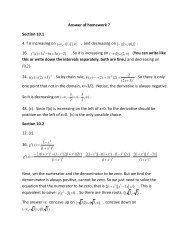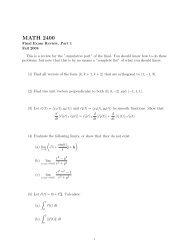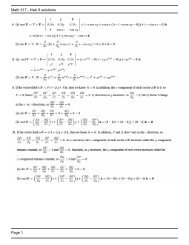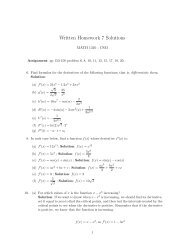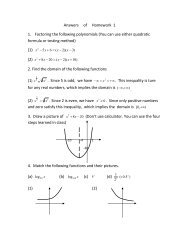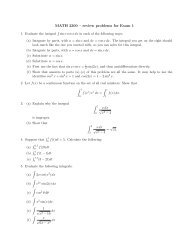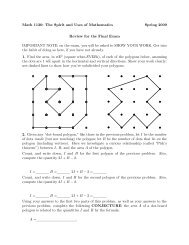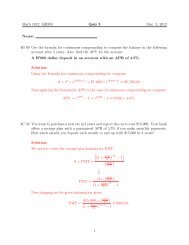Math 6230 Homework #3 Solutions 1. For the differential equation ...
Math 6230 Homework #3 Solutions 1. For the differential equation ...
Math 6230 Homework #3 Solutions 1. For the differential equation ...
You also want an ePaper? Increase the reach of your titles
YUMPU automatically turns print PDFs into web optimized ePapers that Google loves.
<strong>1.</strong> <strong>For</strong> <strong>the</strong> <strong>differential</strong> <strong>equation</strong><br />
<strong>Math</strong> <strong>6230</strong> <strong>Homework</strong> <strong>#3</strong> <strong>Solutions</strong><br />
dx<br />
dt = x2 + 1<br />
t2 , x(0) = a,<br />
+ 1<br />
find <strong>the</strong> solution by separating <strong>the</strong> variables. <strong>For</strong> a given a, what is <strong>the</strong> largest interval<br />
(−ε, ε) on which <strong>the</strong> solution is defined? What is <strong>the</strong> infimum of all such ε as a ranges<br />
over R?<br />
Solution: Separation gives<br />
and integration gives<br />
Plug in t = 0 and x = a to get<br />
and <strong>the</strong>n invert:<br />
or if you like trig identities<br />
dx<br />
x 2 + 1<br />
= dt<br />
t 2 + 1 ,<br />
arctan x = arctan t + c.<br />
arctan x = arctan t + arctan a,<br />
x = tan (arctan t + arctan a),<br />
x =<br />
t + a<br />
1 − ta .<br />
If a > 0, <strong>the</strong> solution is defined on <strong>the</strong> interval (−∞, 1/a), while if a < 0, <strong>the</strong> solution<br />
is defined on <strong>the</strong> interval (−1/a, +∞). (Note that <strong>the</strong> solution must be defined at<br />
t = 0.) Hence if we want symmetric intervals we should have ε = 1/|a|. This blows up<br />
when a = 0; in that case <strong>the</strong> solution is actually defined on all of R. The infimum of ε<br />
over all possible a is clearly zero.<br />
2. Consider <strong>the</strong> coordinate chart (x, y) = F (u, v) = (v cos u, sin u/v). Find a maximal<br />
open set U such that F is a diffeomorphism on U (i.e., F is smooth, invertible, and<br />
F −1 is also smooth). What is <strong>the</strong> image of U in <strong>the</strong> plane? What do <strong>the</strong> coordinate<br />
curves look like?<br />
Solution: First compute DF (u, v) to look for singular points: we have<br />
<br />
xu<br />
DF (u, v) =<br />
<br />
xv −v sin u<br />
=<br />
v<br />
cos u<br />
−1 cos u −v−2 <br />
,<br />
sin u<br />
yu yv<br />
with determinant det DF (u, v) = −v−1 cos 2u. We conclude that <strong>the</strong> open set U must<br />
exclude any points where v = 0 or where cos 2u = 0; <strong>the</strong> latter condition means that<br />
u = π 3π 5π<br />
7π<br />
, u = , u = , or u = (and o<strong>the</strong>r solutions up to periodicity). We thus<br />
4 4 4 4<br />
have various rectangles in <strong>the</strong> uv-plane defined by<br />
<br />
<br />
(2k − 1)π (2k + 1)π<br />
Uk,+ = (u, v) | v > 0 and < u <<br />
4<br />
4<br />
<br />
<br />
(2k − 1)π (2k + 1)π<br />
Uk,− = (u, v) | v < 0 and < u <<br />
4<br />
4<br />
1
with 1 ≤ k ≤ 4 being <strong>the</strong> relevant ones.<br />
We know that F is locally a diffeomorphism on Uk,+ and Uk,−, so we just need to<br />
prove F is bijective in order to make it a global diffeomorphism. To do this, suppose<br />
F (u, v) = F (p, q); <strong>the</strong>n v cos u = q cos p and v −1 sin u = q −1 sin p. Multiplying <strong>the</strong>se<br />
toge<strong>the</strong>r we obtain sin 2u = sin 2p. Using <strong>the</strong> trick A = u + p and B = u − p, we get<br />
sin (A + B) = sin (A − B), and expanding gives ei<strong>the</strong>r sin (u − p) = 0 or cos (u + p) =<br />
0. Thus we have <strong>the</strong> solutions u = p + nπ or u = −p + (n + 1<br />
2 )π.<br />
In <strong>the</strong> first case where u = p + nπ we have (−1) n v cos p = q cos p and v −1 (−1) n sin p =<br />
q −1 sin p, which means v = (−1) n q. So ei<strong>the</strong>r u = p up to a multiple of 2π and v = q,<br />
or u = p + π up to a multiple of 2π and v = −q. Ei<strong>the</strong>r way we cannot have both<br />
points in <strong>the</strong> same set Uk,±.<br />
In <strong>the</strong> second case where u = −p + (n + 1<br />
2 )π, we must have cos u = (−1)n sin p and<br />
sin u = (−1) n cos p, so that <strong>the</strong> two conditions reduce to (−1) n v sin p = q cos p. Can<br />
two such points be in <strong>the</strong> same set? Suppose (2k − 1)π/4 < p < (2k + 1)π/4; <strong>the</strong>n<br />
(n + 1/4 − k/2)π < u < (n + 3/4 − k/2)π, and this is in <strong>the</strong> same interval as p if and<br />
only if n + 1/2 − k = 0, which is impossible.<br />
We conclude that F is actually one-to-one on each of <strong>the</strong> sets Uk,±.<br />
To find <strong>the</strong> image under F of one of <strong>the</strong>se sets (for example U1,+), we look at <strong>the</strong><br />
coordinate curves. <strong>For</strong> fixed u and positive v, <strong>the</strong> map v ↦→ (v cos u, v−1 sin u) = (x, y)<br />
traces out a hyperbola satisfying xy = 1 sin 2u. Hence all points that can be in <strong>the</strong><br />
2<br />
image of F must satisfy |xy| ≤ 1,<br />
which severely constrains <strong>the</strong> set. When u = π/4<br />
2<br />
we get <strong>the</strong> hyperbola xy = 1/2 in <strong>the</strong> first quadrant, and when u = 3π/4 we get <strong>the</strong><br />
hyperbola xy = −1/2 in <strong>the</strong> second quadrant. <strong>For</strong> fixed v > 0 and π/4 < u < 3π/4, <strong>the</strong><br />
map u ↦→ (v cos u, v−1 sin u) traces out a portion of an ellipse satisfying x2 /v2 +v2y2 = 1,<br />
between <strong>the</strong> points ( v √ 2 , 1<br />
v √ 2 ) and (− v √ 2 , 1<br />
v √ 2 ).<br />
We can obtain every point in <strong>the</strong> upper half plane lying below <strong>the</strong> hyperbolas y = 1/2|x|<br />
by just writing down formulas: it’s easy to see that we have u = 1(π<br />
− arcsin (2xy)) in<br />
2<br />
order to have π<br />
3π < u < , and using <strong>the</strong> half-angle formula for sines and cosines, we<br />
4 4<br />
get<br />
<br />
1 −<br />
v =<br />
1 − 4x2y2 √<br />
2x<br />
√ = <br />
2y<br />
1 + 1 − 4x2y2 if x and y are both positive, and a similar formula if x < 0.<br />
The image of coordinate curves under <strong>the</strong> map is shown below.<br />
3. Classically, <strong>the</strong> tangent space to a surface S ⊂ R 3 at a point p ∈ S is <strong>the</strong> set of all<br />
possible vectors γ ′ (0) such that γ(t) is a smooth curve defined on a neighborhood of<br />
t = 0 with γ(0) = p.<br />
If <strong>the</strong> surface is defined by <strong>the</strong> formula F (x, y, z) = xy − 3x 2 z + zyx = 0, compute <strong>the</strong><br />
tangent space at (1, 2, 2) and find a basis for it.<br />
2
Figure 1: Some u-v coordinate lines in <strong>the</strong> set U1,+ = ( π 3π , )×(0, ∞), and <strong>the</strong>ir image under<br />
4 4<br />
<strong>the</strong> map. Blue curves are portions of ellipses, and red curves are portions of hyperbolas.<br />
Solution: Suppose γ(t) = (x(t), y(t), z(t)) is a curve lying in <strong>the</strong> surface S; <strong>the</strong>n for<br />
all time we have<br />
x(t)y(t) − 3x(t) 2 z(t) + z(t)y(t)x(t) = 0.<br />
We assume γ(0) = p = (1, 2, 2), so that x(0) = 1, y(0) = 2, and z(0) = 2. Differentiating<br />
<strong>the</strong> constraint <strong>equation</strong> we get<br />
x ′ (t)y(t)+x(t)y ′ (t)−6x(t)x ′ (t)z(t)−3x(t) 2 z ′ (t)+z ′ (t)y(t)x(t)+z(t)y ′ (t)x(t)+z(t)y(t)x ′ (t) = 0.<br />
If x ′ (0) = a, y ′ (0) = b, and z ′ (0) = c, <strong>the</strong>n plugging in t = 0 gets us<br />
or −6a + 3b − c = 0.<br />
2a + b − 12a − 3c + 2c + 2b + 4a = 0,<br />
We obtain <strong>the</strong> same answer in <strong>the</strong> language of vector calculus by computing <strong>the</strong> gradient:<br />
∇F |(x,y,z) = (Fx, Fy, Fz) = (y − 6xz + zy, x + zx, −3x 2 + yx).<br />
Thus ∇F |(1,2,2) = (−6, 3, −1), and we have ∇F |(1,2,2) · γ ′ (0) = 0. Of course, this is<br />
precisely what <strong>the</strong> Chain Rule says.<br />
Since (a, b, c) ∈ TpS if c = −6a + 3b, a basis is formed for example by <strong>the</strong> vectors<br />
(1, 0, −6) and (0, 1, 3).<br />
4. Suppose F (x, y) = x 2 y − y 3 − 2x. If G satisfies F (x, G(x)) = 0, compute G ′ (x) and<br />
G ′′ (x) in terms of G.<br />
Solution: Just implicit differentiation. We have x 2 G(x) − G(x) 3 − 2x = 0, so that<br />
x 2 G ′ (x) + 2xG(x) − 3G(x) 2 G ′ (x) − 2 = 0. (1)<br />
3
Solving for G ′ (x) gives<br />
G ′ (x) =<br />
2 − 2xG(x)<br />
x2 . (2)<br />
− 3G(x) 2<br />
There are two ways to obtain G ′′ (x): ei<strong>the</strong>r differentiate (1), solve for G ′′ (x), and plug<br />
in (2), or differentiate (2) and <strong>the</strong>n plug in (2). I’ll use <strong>the</strong> first method since I don’t<br />
much care for <strong>the</strong> quotient rule.<br />
We obtain<br />
x 2 G ′′ (x) + 4xG ′ (x) + 2G(x) − 6G(x)G ′ (x) 2 − 3G(x) 2 G ′′ (x) = 0,<br />
and solving for G ′′ (x) gives<br />
Then plugging in G ′ (x) from (2) gives<br />
G ′′ (x) =<br />
G ′′ (x) = 6G(x)G′ (x) 2 − 2G(x) − 4xG ′ (x)<br />
x2 − 3G(x) 2 .<br />
6G(x)<br />
<br />
2−2xG(x)<br />
x2−3G(x) 2<br />
2 <br />
2−2xG(x)<br />
− 2G(x) − 4x x2−3G(x) 2<br />
<br />
x 2 − 3G(x) 2<br />
5. The images here are <strong>the</strong> lower-case and upper-case alphabet in Helvetica font.<br />
Classify <strong>the</strong> lower-case letters by homeomorphism type. <strong>For</strong> which letters is <strong>the</strong> uppercase<br />
version not homeomorphic to <strong>the</strong> lower-case version?<br />
Solution: The equivalence classes for <strong>the</strong> lower-case letters are<br />
{a, b, d, g, p, q}, {c, l, s, v, w, z}, {e}, {f, t, x}, {h, n, r, u, y}, {i, j}, {k, m}, {o}.<br />
The only one that’s not quite obvious is that ‘k’ is homeomorphic to ‘m’, but if you<br />
think about it carefully you’ll see <strong>the</strong> correspondence.<br />
The lower-case letters that are homeomorphic to <strong>the</strong>ir upper-case versions are:<br />
{a, c, k, l, o, s, t, v, w, x, y, z}.<br />
4<br />
.
6. Consider <strong>the</strong> parabolic coordinates (ϕ, U) given by formula (6.2.4) with open set U<br />
given by <strong>the</strong> complement of <strong>the</strong> negative vertical ray. Let fpara(τ, σ) = τ 2 be defined<br />
on <strong>the</strong> set R×(0, ∞). Is <strong>the</strong>re a smooth function f : M → R such that fpara = f ◦ϕ −1 ?<br />
Solution: Let ψ : M → R 2 be <strong>the</strong> Euclidean coordinates (x, y) on <strong>the</strong> plane. Then<br />
<strong>the</strong> transition map is, by <strong>equation</strong> (6.2.4),<br />
(x, y) = φ ◦ ϕ −1 (τ, σ) = στ, 1<br />
2 (τ 2 − σ 2 ) . (3)<br />
Now define f : U → R by f(p) = fpara◦ϕ(p) = fpara(τ, σ) if (τ, σ) = ϕ(p). The question<br />
is whe<strong>the</strong>r we can complete f to all of M, and in order to determine this, we need to<br />
compute f in ano<strong>the</strong>r coordinate chart.<br />
Define frect : φ[U] → R by frect(x, y) = f ◦ φ −1 (x, y). We know that φ[U] consists of<br />
all (x, y) except <strong>the</strong> ray L = {(0, y) | y ≤ 0} (in o<strong>the</strong>r words, <strong>the</strong> negative vertical ray<br />
expressed in coordinates). We compute<br />
frect(x, y) = f ◦ φ −1 (x, y) = fpara ◦ ϕ ◦ φ −1 (x, y).<br />
Now <strong>the</strong> function (τ, σ) = ϕ ◦ φ−1 (x, y) is just <strong>the</strong> inverse of <strong>the</strong> function (3), defined<br />
on L, with values τ > 0 and σ ∈ R. To compute it, just solve (3) to get<br />
⎛<br />
<br />
(τ, σ) = ⎝ y + x2 + y2 x<br />
, <br />
y + x2 + y2 ⎞<br />
⎠ .<br />
Since fpara(τ, σ) = τ 2 , we conclude that<br />
frect(x, y) = τ(x, y) 2 = y + x 2 + y 2<br />
on <strong>the</strong> complement of L, i.e., as long as x = 0, or x = 0 and y > 0.<br />
The question is now whe<strong>the</strong>r frect extends to all of R 2 ; if it does, <strong>the</strong>n f = frect ◦ φ is<br />
defined on all of M since φ is defined on all of M. Unfortunately frect is not smooth<br />
in any neighborhood of <strong>the</strong> origin; we have<br />
f(0, y) = y + |y| =<br />
<br />
0 y ≤ 0<br />
2y y > 0 ,<br />
so that fy(0, 0) does not exist. Hence although <strong>the</strong>re is a continuous f : M → R, it<br />
cannot be smooth in coordinate charts.<br />
7. Recall that a topological space M is second-countable if <strong>the</strong>re is a countable collection<br />
{Ωn : n ∈ N} of open sets such that every o<strong>the</strong>r open set U ⊂ M is equal to <strong>the</strong> union<br />
of all <strong>the</strong> sets Ωn that it contains.<br />
(a) Prove that R is second-countable. (Hint: <strong>the</strong> rationals are countable.)<br />
Solution: Consider <strong>the</strong> set of all open intervals (a, b) such that a, b ∈ Q; this is a<br />
subset of Q × Q, so it is a countable collection. Let U ⊂ R be any open set. Let<br />
5
N = {(a, b) ∈ Q × Q | a < b and (a, b) ⊂ U} be an at-most-countable subset of<br />
Q × Q, <strong>the</strong> set of all rational endpoints of open intervals contained in U. Define<br />
V = <br />
(a,b)∈N (a, b) to be <strong>the</strong> union of <strong>the</strong>se intervals.1 Clearly V ⊂ U. We need<br />
to show U ⊂ V .<br />
Let x ∈ U be any point. There is an ε > 0 such that (x − ε, x + ε) ⊂ U, and<br />
by density of <strong>the</strong> rationals, <strong>the</strong>re are rationals a ∈ (x − ε, x) and b ∈ (x, x + ε).<br />
Hence x ∈ (a, b) ⊂ (x − ε, x + ε) ⊂ U, and thus x ∈ V . We conclude that U ⊂ V ,<br />
so U = V . Hence every open set is <strong>the</strong> union of <strong>the</strong> rational-endpoint intervals it<br />
contains.<br />
(b) A topological space M is Lindelöf if for every every family of open sets that<br />
covers M, <strong>the</strong>re is a countable subcover that still covers M. Prove that every<br />
second-countable space is Lindelöf.<br />
Solution: Let W = {Ωn | n ∈ N} be a countable basis, and let Y = {Yi | i ∈ I}<br />
be a family of open sets that covers M for some uncountable set I.<br />
Let C be <strong>the</strong> subset of N such that n ∈ C if Ωn ⊂ Yi for some i ∈ I; let f : C → I<br />
be a function that picks an i for which this is true. In o<strong>the</strong>r words Ωn ⊂ Yf(n).<br />
Obviously C is countable; I claim that <strong>the</strong> union Q = <br />
n∈C Yf(n) covers M.<br />
So let x ∈ M be any point; <strong>the</strong>n x ∈ Yi for some i ∈ I. Since W is a basis, <strong>the</strong>re is<br />
some n such that x ∈ Ωn ⊂ Yi. Now perhaps i = f(n), but since Ωn is contained<br />
in some set in Y, we know n ∈ C. Thus since x ∈ Ωn and Ωn ⊂ Yf(n), we know<br />
x ∈ Q. Thus M = Q and we have found a countable subfamily of Y that covers<br />
M.<br />
8. Suppose we have a collection of bijective functions (φ, U) from a set M to R n such<br />
that <strong>the</strong> union of all U covers M and whenever U ∩ V is nonempty, <strong>the</strong> function<br />
φ ◦ ψ −1 : ψ[U ∩ V ] ⊂ R n → φ[U ∩ V ] ⊂ R n is a homeomorphism. Define a set Ω ⊂ M<br />
to be open if and only if φ[Ω ∩ U] is open for every chart (φ, U). Check carefully that<br />
this satisfies <strong>the</strong> conditions for a topology on M.<br />
Solution: We check <strong>the</strong> three conditions.<br />
• M and ∅ are open. M is open since φ[M ∩ U] = R n is open in itself for every<br />
(φ, U). And ∅ is open since φ[∅ ∩ U] = ∅ is open in R n .<br />
• If Ω and Ψ are open, <strong>the</strong>n Ω ∩ Ψ is open. This comes from <strong>the</strong> formula<br />
Now since φ is a bijection, we have<br />
φ[(Ω ∩ Ψ) ∩ U] = φ[(Ω ∩ U) ∩ (Ω ∩ V )].<br />
φ[(Ω ∩ U) ∩ (Ω ∩ V )] = φ[Omega ∩ U] ∩ φ[Ω ∩ V ],<br />
and by assumption <strong>the</strong> latter two sets are open in R n . So <strong>the</strong>ir intersection is<br />
open as well, as desired.<br />
1 It is annoying that (a, b) means both an ordered pair and an open interval.<br />
6
• If Ωi is a collection of open sets for i ∈ I for some index set I, <strong>the</strong>n ∪i∈IΩi is<br />
open. The DeMorgan law says that U ∩ (∪i∈IΩi) = ∪i∈I(U ∩ Ωi), and since φ is<br />
a bijection we again have<br />
φ[U ∩ (∪i∈IΩi)] = ∪i∈Iφ[U ∩ Ωi].<br />
The latter is open since it is <strong>the</strong> union of open sets in R n .<br />
Note that we never actually need to use <strong>the</strong> condition that φ◦ψ −1 is a homeomorphism<br />
on its domain to get a topology on M. But if that condition is not satisfied, we may get<br />
a strange-looking manifold. <strong>For</strong> example, let M ∼ = R (abstractly) with ψ <strong>the</strong> identity<br />
map, and let φ be any discontinuous bijection such as<br />
⎧<br />
⎪⎨ x x < 0<br />
φ(x) = 1 − x 0 ≤ x ≤ 1<br />
⎪⎩<br />
x x > <strong>1.</strong><br />
Now for 0 < ε < 1, <strong>the</strong> set (1 − ε, 1 + ε) ⊂ M is not open in this topology since<br />
φ(1 − ε, 1 + ε) = [0, ε) ∪ (1, 1 + ε)[0, 1) ∪ (1, 2) is not open in R. More generally <strong>the</strong>re<br />
are no “small” open sets containing <strong>the</strong> point 1 ∈ M. Thus for example <strong>the</strong> induced<br />
topology on M is not Hausdorff: <strong>the</strong>re is no open set containing 1 that does not contain<br />
1<br />
1 1 1<br />
, and <strong>the</strong> sequence ( , , , . . .) converges to <strong>1.</strong> Fur<strong>the</strong>rmore, in such a topology <strong>the</strong><br />
2 2 2 2<br />
map φ: M → R is not even continuous!<br />
9. Suppose we are in <strong>the</strong> same situation as <strong>the</strong> previous problem. Show that a function<br />
f : M → R is continuous if and only if, for every chart (φ, U), <strong>the</strong> usual multivariable<br />
function f ◦ φ −1 : φ[U] ⊂ R n → R is continuous.<br />
Solution: Since φ is a bijection, we know that<br />
(f ◦ φ −1 ) −1 [W ] = φ[f −1 [W ] ∩ U]<br />
for any open set W ⊂ R. Thus we conclude that if (f ◦ φ −1 ) −1 [W ] is open for every<br />
open W and every chart φ, <strong>the</strong>n f −1 [W ] is open, and conversely. So f is continuous if<br />
and only if f ◦ φ −1 is continuous.<br />
10. Suppose M is a compact Hausdorff topological space and N is a Hausdorff topological<br />
space. Let f : M → N be a continuous bijection onto a subset of N. Prove that f is a<br />
homeomorphism onto its image.<br />
Solution: Let P = f[M]; <strong>the</strong>n g = f −1 : P → M exists. Since N is Hausdorff, so is<br />
<strong>the</strong> subset P .<br />
We want to prove that g is continuous. To do this, it is sufficient to show that g−1[K]<br />
is closed in P whenever K is closed in M. Since g −1 [K] = f[K], we just have to show<br />
that f[K] is compact in P for any closed set K in M.<br />
Since M is compact and K is closed in M, we know K is compact. Since f is continuous,<br />
f[K] is a compact set in P . Finally, since P is Hausdorff and f[K] is compact in P , it<br />
must be closed in P .<br />
7


